Abstract
The likelihood ratio, logistic regression, and artificial neural networks models are applied and verified for analysis of landslide susceptibility in Youngin, Korea, using the geographic information system. From a spatial database containing such data as landslide location, topography, soil, forest, geology, and land use, the 14 landslide-related factors were calculated or extracted. Using these factors, landslide susceptibility indexes were calculated by likelihood ratio, logistic regression, and artificial neural network models. Before the calculation, the study area was divided into two sides (west and east) of equal area, for verification of the models. Thus, the west side was used to assess the landslide susceptibility, and the east side was used to verify the derived susceptibility. The results of the landslide susceptibility analysis were verified using success and prediction rates. The verification results showed satisfactory agreement between the susceptibility map and the existing data on landslide locations.










Similar content being viewed by others
References
Atkinson PM, Massari R (1998) Generalized linear modeling of susceptibility to landsliding in the central Apennines, Italy. Comput Geosci 24:373–385
Benediktsson JA, Swain PH, Ersoy OK (1990) Multisource data classification and feature extraction with artificial neural networks. IEEE Trans Geosci Remote Sens 28:540–552
Chung CF, Fabbri AG (1999) Probabilistic prediction models for landslide hazard mapping. Photogramm Eng Remote Sensing 65:1389–1399
Clerici A, Perego S, Tellini C, Vescovi P (2002) A procedure for landslide susceptibility zonation by the conditional analysis method. Geomorphology 48:349–364
Dai FC, Lee CF (2002) Landslide characteristics and slope instability modeling using GIS, Lantau Island, Hong Kong. Geomorphology 42:213–228
Donati L, Turrini MC (2002) An objective method to rank the importance of the factors predisposing to landslides with the GIS methodology: application to an area of the Apennines (Valnerina; Perugia, Italy). Eng Geol 63:277–289
Fernández CI, Castillo TF, Hamdouni RE, Montero JC (1999) Verification of landslide susceptibility mapping: a case study. Earth Surf Process Landf 24:537–544
Gokceoglu C, Sonmez H, Ercanoglu M (2000) Discontinuity controlled probabilistic slope failure risk maps of the Altindag (settlement) region in Turkey. Eng Geol 55:277–296
Guzzetti F, Carrarra A, Cardinali M, Reichenbach P (1999) Landslide hazard evaluation: a review of current techniques and their application in a multi-scale study, Central Italy. Geomorphology 3:181–216
Hines JW (ed) (1997) Fuzzy and artificial neural approaches in engineering. Wiley, New York
Larsen M, Torres-Sanchez A (1998) The frequency and distribution of recent landslides in three montane tropical regions of Puerto Rico. Geomorphology 24:309–331
Lee S, Min K (2001) Statistical analysis of landslide susceptibility at Youngin, Korea. Environ Geol 40:1095–1113
Lee S, Chwae U, Min K (2002a) Landslide susceptibility mapping by correlation between topography and geological structure: the Janghung area, Korea. Geomorphology 46:149–116
Lee S, Choi J, Min K (2002b) Landslide susceptibility analysis and verification using the Bayesian probability model. Environ Geol 43:121–130
Lee S, Choi U (2003) Development of GIS-based geological hazard information system and its application for landslide analysis in Korea. Geosci 7:243–252
Lee S, Ryu JH, Min K, Won JS (2003a) Landslide susceptibility analysis using GIS and artificial neural network. Earth Surf Process Landf 27:1361–1376
Lee S, Ryu JH, Lee MJ, Won JS (2003b) Landslide susceptibility analysis using artificial neural network at Boeun, Korea. Environ Geol 44:820–833
Lee S, Ryu JH, Won JS, Park HJ (2004a) Determination and application of the weights for landslide susceptibility mapping using an artificial neural network. Eng Geol 71:289–302
Lee S, Choi J, Min K (2004b) Probabilistic landslide hazard mapping using GIS and remote sensing data at Boeun, Korea. Int J Remote Sens 25:2037–2052
Lee S (2005) Application of logistic regression model and its validation for landslide susceptibility mapping using GIS and remote sensing data. Int J Remote Sens 26:1477–1491
Lee S, Talib JA (2005) Probabilistic landslide susceptibility and factor effect analysis. Environ Geol 47:982–990
Lee S, Dan NT (2005) Probabilistic landslide susceptibility mapping in the Lai Chau province of Vietnam: focus on the relationship between tectonic fractures and landslides. Environ Geol 48:778–787
Lee S, Evangelista DG (2006) Earthquake-induced landslide-susceptibility mapping using an artificial neural network. Nat Hazards Earth Syst Sci 6:687–695
Lee S, Lee MJ (2006) Detecting landslide location using KOMPSAT 1 and its application to landslide susceptibility mapping at the Gangneung area, Korea. Adv Space Res 38:2261–2271
Lee S, Sambath T (2006) Landslide susceptibility mapping in the Damrei Romel area, Cambodia using frequency ratio and logistic regression models. Environ Geol 50:847–855
Lee S, Ryu JH, Lee MJ, Won JS (2006) The application of artificial neural networks to landslide susceptibility mapping at Janghung, Korea. Math Geol 38:199–220
Lee S, Pradhan B (2007) Landslide hazard mapping at Selangor, Malaysia using frequency ratio and logistic regression models. Landslide 4:33–41
Luzi L, Pergalani F, Terlein MTJ (2000) Slope vulnerability to earthquakes at subregional scale, using probabilistic techniques and geographic information systems. Eng Geol 58:313–336
Mandy LG, Andrew MW, Richard AS, Stephan GC (2001) Assessing landslide potential using GIS, soil wetness modeling and topographic attributes, Payette River, Idaho. Geomorphology 37:149–165
Paola JD, Schowengerdt RA (1995) A review and analysis of back propagation artificial neural networks for classification of remotely sensed multi-spectral imagery. Int J Remote Sens 16:3033–3058
Park Y, Kim K, Yeo W (1993) A study on Youngin–Ansung landslides in 1991 (in Korean). Korean Geotech J 9:103–116
Randall WJ, Edwin LH, John AM (2000) A method for producing digital probabilistic seismic landslide hazard maps. Eng Geol 58:271–289
Temesgen B, Mohammed MU, Korme T (2001) Natural hazard assessment using GIS and remote sensing methods, with particular reference to the landslides in the Wondogenet Area, Ethiopia. Phys Chem Earth Part C Solar-Terr Planet Sci 26:665–675
Turrini MC, Visintainer P (1998) Proposal of a method to define areas of landslide hazard and application to an area of the Dolomites, Italy. Eng Geol 50:255–265
Van Westen C, Rengers N, Soeters R (2003) Use of geomorphological information in indirect landslide susceptibility assessment. Nat Hazards 30:399–419
Wang J, Rahman MS (1999) An artificial neural network model for liquefaction-induced horizontal ground displacement. Soil Dyn Earthqu Eng 18:555–568
Acknowledgements
This research was supported by the Basic Research Project of the Korea Institute of Geoscience and Mineral Resources (KIGAM) funded by the Ministry of Science and Technology of Korea.
Author information
Authors and Affiliations
Corresponding author
Rights and permissions
About this article
Cite this article
Lee, S., Ryu, JH. & Kim, IS. Landslide susceptibility analysis and its verification using likelihood ratio, logistic regression, and artificial neural network models: case study of Youngin, Korea. Landslides 4, 327–338 (2007). https://doi.org/10.1007/s10346-007-0088-x
Received:
Accepted:
Published:
Issue Date:
DOI: https://doi.org/10.1007/s10346-007-0088-x




